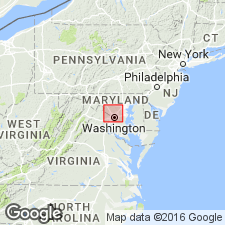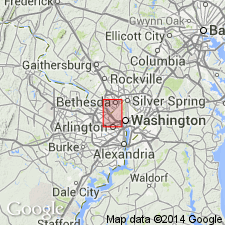
- Usage in publication:
-
- Kensington granite gneiss
- Modifications:
-
- Named
- Dominant lithology:
-
- Granite
- Gneiss
- AAPG geologic province:
-
- Piedmont-Blue Ridge province
Summary:
Name Kensington granite gneiss applied to highly foliated, coarse biotite granite. This youngest crystalline rock is a discordant granodiorite invading the schist in bodies that are too small to be shown on map. The granodiorite may be responsible for a great deal of the metamorphism of this area. Mapped in District of Columbia west of Rock Creek Park. Derivation of name not given, but probably Kensington, MD. Age unknown.
Source: GNU records (USGS DDS-6; Reston GNULEX).

- Usage in publication:
-
- Kensington Quartz Diorite
- Modifications:
-
- Revised
- AAPG geologic province:
-
- Piedmont-Blue Ridge province
Summary:
Name applied to thin wedge of quartz diorite gneiss that runs north from lower Rock Creek Park in D.C. to Norwood, MD, a distance of 15 mi. North of Wheaton, the gneiss pinches out, then reappears and splits into two prongs. A parallel lens of gneiss, 5 mi long and 300 to 400 yds wide, lies a short distance east. Invades Wissahickon Schist as thin concordant wedges and lenses. Cuts plutonic rocks of Georgetown Complex (new). Age is early Paleozoic.
Source: GNU records (USGS DDS-6; Reston GNULEX).

- Usage in publication:
-
- Kensington Tonalite*
- Modifications:
-
- Geochronologic dating
- AAPG geologic province:
-
- Piedmont-Blue Ridge province
Summary:
An isotopic age of 460+/-4 Ma (Early Ordovician) for the Kensington Tonalite was determined from single crystal zircon dating.
Source: GNU records (USGS DDS-6; Reston GNULEX).

- Usage in publication:
-
- Kensington Tonalite*
- Modifications:
-
- Overview
- AAPG geologic province:
-
- Piedmont-Blue Ridge province
Summary:
The Kensington Tonalite in the mapped area forms two elongate plutons that consist of well-foliated, coarse-grained rock composed chiefly of oligoclase, quartz, biotite, and muscovite and lesser amounts of microcline and garnet. Some outcrops show probable relict igneous flow foliation. The Kensington is of Early Ordovician age.
Source: GNU records (USGS DDS-6; Reston GNULEX).

- Usage in publication:
-
- Kensington Tonalite*
- Modifications:
-
- Revised
- Redescribed
- Age modified
- Geochronologic dating
- Dominant lithology:
-
- Tonalite
- AAPG geologic province:
-
- Piedmont-Blue Ridge province
Summary:
Kensington Quartz Diorite as used by Hopson (1964) is here revised as Kensington Tonalite. Recent geochemical data revises its place within the IUGS rock classification scheme to a tonalite. The Kensington is of Early Ordovician age.
Source: GNU records (USGS DDS-6; Reston GNULEX).
For more information, please contact Nancy Stamm, Geologic Names Committee Secretary.
Asterisk (*) indicates published by U.S. Geological Survey authors.
"No current usage" (†) implies that a name has been abandoned or has fallen into disuse. Former usage and, if known, replacement name given in parentheses ( ).
Slash (/) indicates name conflicts with nomenclatural guidelines (CSN, 1933; ACSN, 1961, 1970; NACSN, 1983, 2005, 2021). May be explained within brackets ([ ]).

